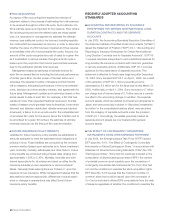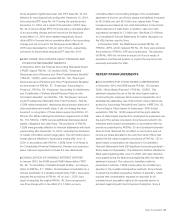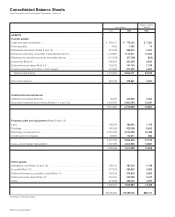Sony 2005 Annual Report Download - page 70
Download and view the complete annual report
Please find page 70 of the 2005 Sony annual report below. You can navigate through the pages in the report by either clicking on the pages listed below, or by using the keyword search tool below to find specific information within the annual report.Sony Corporation 67
stock acquisition rights have been met. EITF Issue No. 04-8 is
effective for reporting periods ending after December 15, 2004.
Sony adopted EITF Issue No. 04-8 during the quarter ended
December 31, 2004. As a result of the adoption of EITF Issue
No. 04-8, Sony’s diluted EPS of income before cumulative effect
of an accounting change and net income for the fiscal year
ended March 31, 2004 were restated respectively. Sony’s
diluted EPS of income before cumulative effect of an accounting
change and net income for the fiscal year ended March 31,
2005 were decreased by 7.26 yen and 7.06 yen, respectively,
compared to those before adopting EITF Issue No. 04-8.
■EMPLOYERS’ DISCLOSURES ABOUT PENSIONS AND
OTHER POSTRETIREMENT BENEFITS
In December 2003, the Financial Accounting Standards Board
(“FASB”) issued FAS No. 132 (revised 2003), “Employers’
Disclosures about Pensions and Other Postretirement Benefits”
(“FAS No. 132(R)”), which revised FAS No. 132, “Employers’
Disclosures about Pensions and Other Postretirement Benefits”,
an amendment of FAS No. 87, “Employers’ Accounting for
Pensions”, FAS No. 88, “Employers’ Accounting for Settlements
and Curtailments of Defined Benefit Pension Plans and for
Termination Benefits”, and FAS No. 106, “Employers’ Account-
ing for Postretirement Benefits Other Than Pensions”. FAS No.
132(R) revised employers’ disclosures about pension plans and
other postretirement benefit plans. It did not change the mea-
surement or recognition of those plans required by FAS No. 87,
88 and 106. While retaining the disclosure requirements of FAS
No. 132, FAS No. 132(R) requires additional disclosures about
assets, obligations and cash flows. The provisions of FAS No.
132(R) were generally effective for financial statements with fiscal
years ending after December 15, 2003, excluding the disclosure
of certain information about foreign plans. The information about
foreign plans is effective for fiscal years ending after June 15,
2004. In accordance with FAS No. 132(R), Note 15 of Notes to
the Consolidated Financial Statements, Pension and severance
plans, has been expanded to include the new disclosures.
■CONSOLIDATION OF VARIABLE INTEREST ENTITIES
In January 2003, the FASB issued FASB Interpretation (“FIN”)
No. 46, “Consolidation of Variable Interest Entities - an Interpre-
tation of ARB No. 51”. FIN No. 46 addresses consolidation by a
primary beneficiary of a variable interest entity (“VIE”). Sony early
adopted the provisions of FIN No. 46 on July 1, 2003. As a
result of adopting the original FIN No. 46, Sony recognized a
one-time charge with no tax effect of 2.1 billion yen as a
cumulative effect of accounting change in the consolidated
statement of income, and Sony’s assets and liabilities increased
by 95.3 billion yen and 98.0 billion yen, respectively. These
increases were treated as non-cash transactions in the consoli-
dated statement of cash flows. In addition, cash and cash
equivalents increased by 1.5 billion yen. See Note 23 of Notes
to Consolidated Financial Statements for further discussion on
the VIEs that are used by Sony.
In December 2003, the FASB issued revised FIN No. 46
(“FIN No. 46R”), which replaced FIN No. 46. Sony early adopted
the provisions of FIN No. 46R upon its issuance. The adoption
of FIN No. 46R did not have an impact on Sony’s results of
operations and financial position or impact the way Sony had
previously accounted for VIEs.
RECENT PRONOUNCEMENTS
■ACCOUNTING FOR STOCK-BASED COMPENSATION
In December 2004, the FASB issued FAS No. 123 (revised
2004), “Share-Based Payment” (“FAS No. 123(R)”). This
statement requires the use of the fair value based method
of accounting for employee stock-based compensation and
eliminates the alternative use of the intrinsic value method pre-
scribed by Accounting Principle Board Opinion (“APB”) No. 25,
“Accounting for Stock Issued to Employees.” With limited
exceptions, FAS No. 123(R) requires that the grant-date fair
value of share-based payments to employees be expensed over
the period the service is received. Sony has accounted for its
employee stock-based compensation in accordance with the
provisions prescribed by APB No. 25 and its related interpreta-
tions and has disclosed the net effect on net income and net
ncome per share allocated to the common stock if Sony had
applied the fair value recognition provisions of FAS No. 123 to
stock-based compensation as described in Consolidated
Financial Statements Note 2(2) Significant accounting policies—
Stock-based compensation. This statement shall be effective for
fiscal years beginning after June 15, 2005, with early adoption
encouraged during the fiscal years beginning after the date this
statement is issued. The options for transition methods
prescribed in FAS No. 123(R) include either the modified pro-
spective or the modified retrospective methods. Sony intends
to adopt the modified prospective method of transition, which
requires that compensation expense be recorded for all
unvested stock acquisition rights as the requisite service is
rendered beginning with the first period of adoption. Sony is
BH6/30 Adobe PageMaker 6.0J /PPC
























